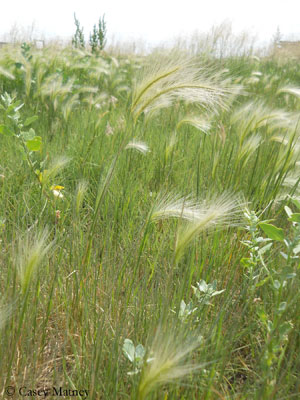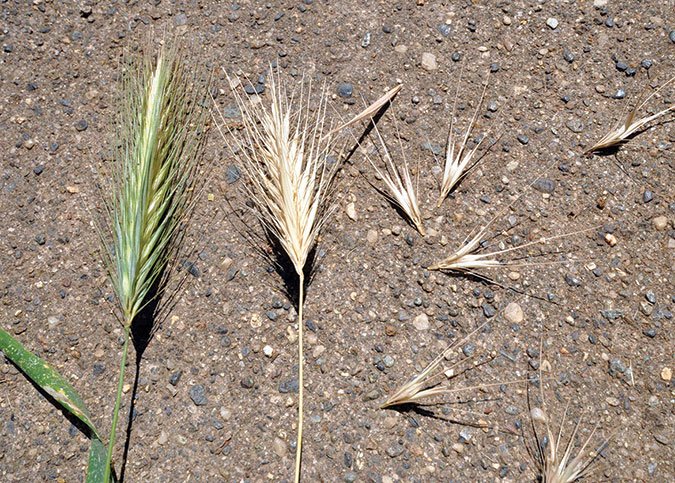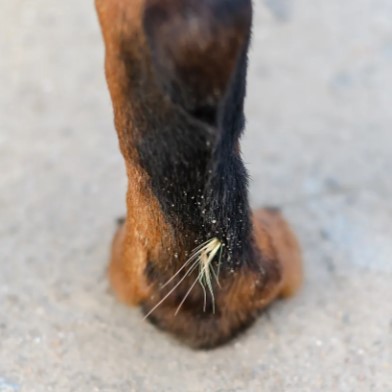
Foxtails are a grass-like weed that grows prolifically throughout Colorado. It grows as well in pastures and lawns as it does in gravel driveways and cracks in the sidewalk. When the plant starts to grow in spring, it’s actually lovely; it’s a bright green, soft, fast-growing grass that many dogs find irresistible for chewing. As it begins to mature, it produces the structure that resembles a fox’s tail: a thick, bristly spike that starts out green and soft. As temperatures increase and the rains end, the grass begins to dry out and the spikes turn yellow. The drier they get, the more brittle they become, and the plume-like “foxtail” starts to fall apart into individual segments, each tipped by a sharp seed – creating a severe hazard to our pets.
Foxtails Are Designed to Penetrate Quickly
The seeds are very hard and tipped with a sharp point that can puncture your dog’s skin and enter his body. Attached to the seed are long, fibrous awns, which are covered with microscopic bristles that are arranged in a single direction, like the teeth on a rasp or nail file – or a porcupine quill. Any contact with these tiny bristles literally pushes the seed forward.
The three most common hazards for our pets are the NOSE, EARS, and between dog TOES. Once inside, the seeds start a relentless crawl forward, traveling deeper into a dog’s tissue. To these bristly seeds, longer, thicker, or curly coats behave a little like the “loop” side of a Velcro-type hook-and-loop fastener; a foxtail can stick to the coat, and wherever it sticks, it will start to burrow, enabling the seeds to penetrate anywhere on the furry dogs’ bodies.
The take-home point: If your dog has been anywhere near foxtails, and shows any sign of discomfort or irritation – shaking her head, an uncharacteristic squint, repetitively licking her paw or other part of her body, sneezing, coughing, gagging – call your vet and make an appointment as soon as possible.


What You Can Do
- Check your dog after every exposure to the weeds, especially between his toes. If he has the kind of coat that attracts foxtails, brush or comb him thoroughly. A bath with plenty of conditioner can help you find pesky seeds.
- Pull up the foxtail plant by the roots as soon as it begins to produce its signature plumes in the spring. Before the plumes appear, it’s hard to tell which grass is foxtail grass and which is not. Dispose of the whole plants – bag them securely and send them to the landfill. The seeds often survive even intense composting; so skip the compost bin.
- Keep pets out of dry, grassy fields and roadsides.
- Keep your pet’s coat clean and well-groomed. This may mean clipping fur short to help reduce grass seed accumulation and facilitate daily inspections.
- Inspect your pet daily for hair mats (where grass awns like to hide) and examine the area between their toes.
- Clip the hair between paw pads to reduce the potential for picking up seeds.
It bears repeating: If your dog exhibits any sign or abnormal behavior after being exposed to foxtails, go to a veterinary clinic. Watch for excessive blinking or pawing at the eyes, sneezing, coughing, gagging, head-shaking, paw-licking (or any targeted licking, especially if you see a raw, red bump), or pain or discomfort while or after urinating.
< Read More Articles on Our Resources Page